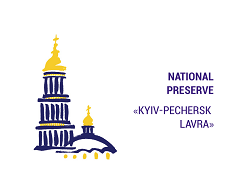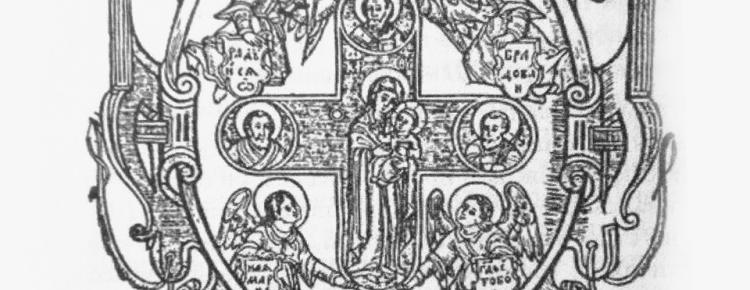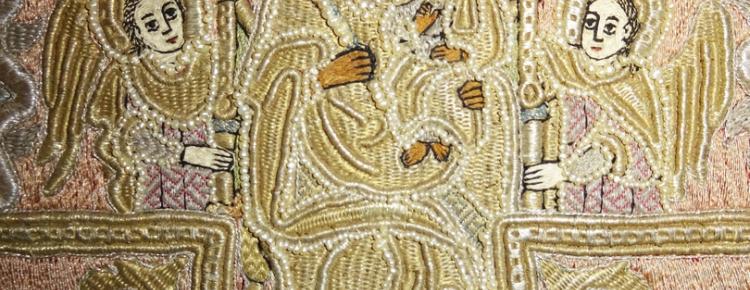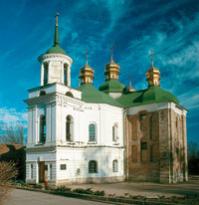Artistic Heritage of Kyiv-Pechersk Lavra “Holy Virgin of Kupyatych” epigonation from the Fund collection of the National Preserve “Kyiv-Pechersk Lavra” (late 17th - early 18th century)
 Dear friends!
Dear friends!
We continue to acquaint you with Artistic Heritage of Kyiv-Pechersk Lavra.
Today we are going to talk about the element of liturgical attire worn by the higher clergy in the late 17th - early 18th centuries. It is epigonation with the embroidered image of the Holy Virgin of Kupiatych on it (KPL-T-171, 37.0 × 37.0 cm).
Miraculous Kupiatych icon is a sacred Orthodox relic. It was a bronze double edged encolpion in the form of a cross (12.0 × 12.0 cm). On one of its sides there was the image of Crucifixion, on the other - a life-size image of the Virgin and Child with Saints. According to the legend, the cross was miraculously revealed in 1182. It was found on a tree close to the village of Kupyatychi, which is near the Belarusian city of Pinsk. The church, built in that place in honor of the revealed relic, was destroyed during the Mongol invasion. The relic itself was lost and reappeared only at the end of the 15th century. To commemorate that event Pinsk Prince Fedir Yaroslavovych (who ruled during 1501–1520 years) built a new church, which went through numerous restorations in the course of time. In 1628–1629, monks founded a monastery there. The image of the Holy Virgin of Kupyatych became famous for many miracles. For the first time they were collected in the book “Teraturgima” (1638), compiled by Athanasius Kalnofoisky, the monk of Kyiv-Pechersk Lavra that received the blessing of Kyiv Metropolitan Petro Mohyla. Due to the oppression of the Uniates in 1655, the relic was moved to Kyiv and placed in St. Sophia Cathedral. In 1700, Kyiv Metropolitan Varlaam Yasynsky ordered that precious embossed robes be made for the Kupyatych icon, which was earlier fixed on a silver gilded board. In the 1930s, the icon was transferred to the All-Ukrainian Museum Town located in the territory of Kyiv-Pechersk Lavra. The fate of the icon in the postwar period remains unknown.
The popularity of the “Holy Virgin of Kupyatych” icon resulted in the appearance of its many miraculous images both, in printed publications and on liturgical objects. The first engraved image of the icon appeared in “Teraturgima”. The iconography of the icon could vary and differ significantly from the original. Take, for example, the image of Kupyatych icon on the epigonation that belongs to the Fund collection of the Preserve. In the center of the cross, one can see the image of the Holy Virgin and Child. They are depicted in the “throne-sat”, not standing position. The high back of the chair is supported by two kneeling angels. The cherubs overshadow the Holy Virgin. At the ends of the cross in round scalloped medallions one can see waist images of evangelists Luke, Matthew, John and Mark (in the original version of the cross icon the image of St. Nicholas was atop, that of St. Paul was on the right, and that of St. Peter - on the left). Between the beams of the cross, there are four embroidered seraphim. They turn their faces to the Holy Virgin. The epigonation was preserved in the sacristy of Lavra’s Dormition Cathedral. It was part of the vestment of the archimandrites of Kyiv-Pechersk monastery. Therefore, it is possible that representatives of the Lavra clergy were involved in the development of its composition. Elegant drawing, extremely high level of embroidery, as well as the combination of different techniques give grounds to include this epigonation into the range of works made by Lavra creative artists and masters of Kyiv Ascension convent in the late 17th - early 18th centuries. The fact that attracts additional attention is that the epigonation was originally made of red velvet. In the first half of the 19th century, the velvet was removed, and the reinforcing fabric of the relic was sewn with pink silk and metal threads. Apparently, at the same time, the faces and hands of some of the images were restored: white silk inserts with contour of facial features were replaced by brown silk embroidery.
Captions to the illustrations:
1. Image of the Kupyatych icon from “Teraturgima” (Kyiv, 1638)
2. Epigonation with the image of the Holy Virgin of Kupyatych. Late 17th - early 18th century (with the restored areas made in the first half of the 19th century). (KPL-T-171)
3. Fragment of the epigonation with the image of the Holy Virgin of Kupyatych.
Prepared by A. Varivoda, Ph.D.,
Leading research associate
Study of Artistic Heritage Research Division National Preserve “Kyiv-Pechersk Lavra”
#ArtisticHeritage















